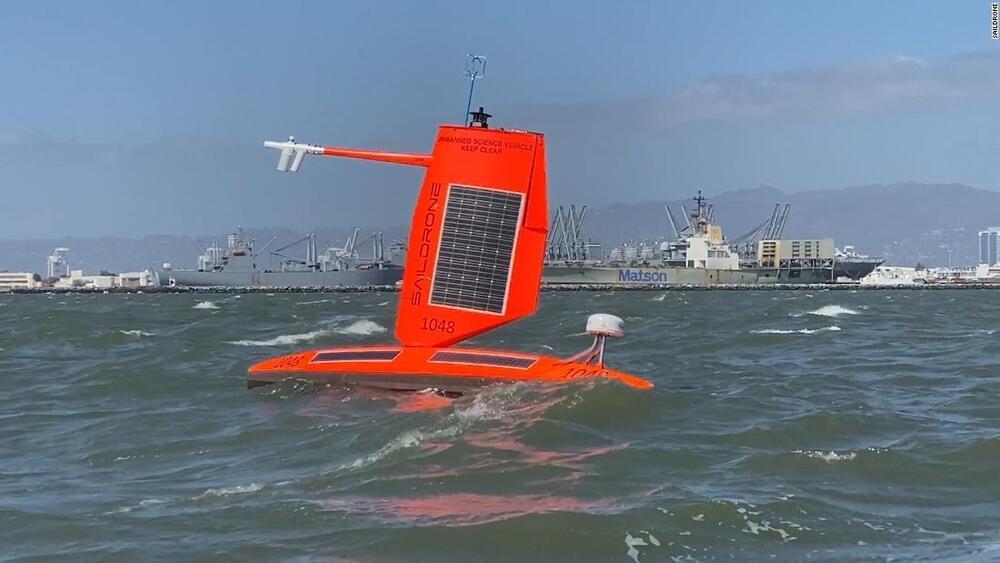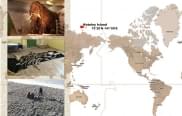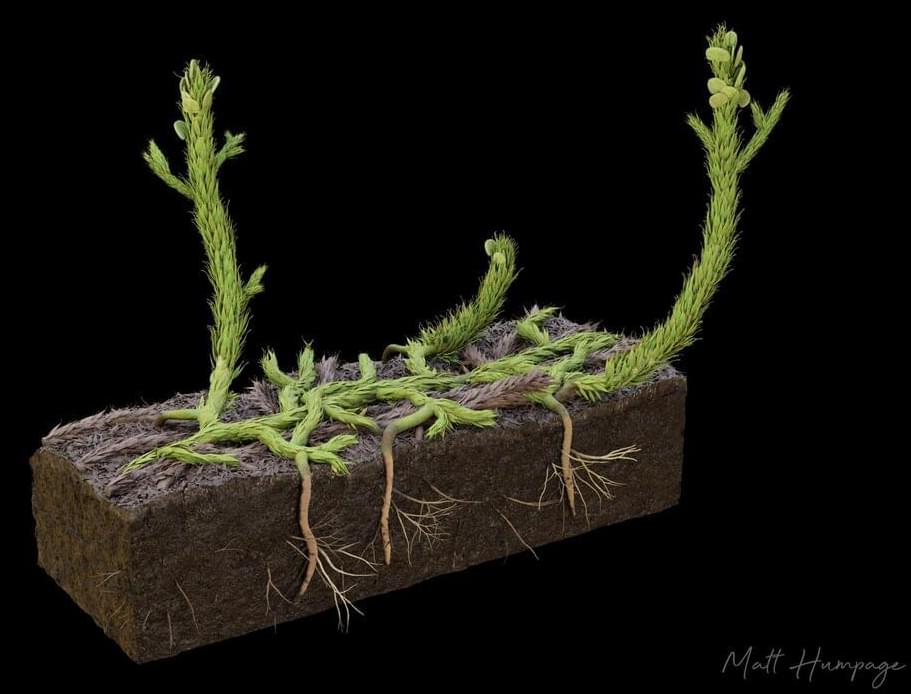Not much is known about the vortex beams’ properties at the moment, but scientists plan to learn more by crashing them into other particles.



These brightly colored robotic boats seem to have a death wish.
The brightly-colored robotic boats made by Saildrone seem to have a death wish.
Saildrone makes autonomous ocean vessels to study the environment. This summer, the Silicon Valley startup sent five of its vessels directly into the path of hurricanes in the Atlantic Ocean. While airplanes can fly through hurricanes, the screaming winds kick up such huge waves that attempting to sail boats right into them is something best to be avoided.
Saildrone’s vessels are uncrewed, and built to survive hurricane winds and huge waves. Scientists are excited that the vessels could improve our understanding of how storms intensify.

When a cloudy plume of ice and water vapor billows up above the top of a severe thunderstorm, there’s a good chance a violent tornado, high winds or hailstones bigger than golf balls will soon pelt the Earth below.
A new Stanford University-led study, published Sept. 10 in Science, reveals the physical mechanism for these plumes, which form above most of the world’s most damaging tornadoes.
Previous research has shown they’re easy to spot in satellite imagery, often 30 minutes or more before severe weather reaches the ground. “The question is, why is this plume associated with the worst conditions, and how does it exist in the first place? That’s the gap that we are starting to fill,” said atmospheric scientist Morgan O’Neill, lead author of the new study.
It was a moment three years in the making, based on intensive research and design work: On Sept. 5 for the first time, a large high-temperature superconducting electromagnet was ramped up to a field strength of 20 tesla, the most powerful magnetic field of its kind ever created on Earth. That successful demonstration helps resolve the greatest uncertainty in the quest to build the world’s first fusion power plant that can produce more power than it consumes, according to the project’s leaders at MIT and startup company Commonwealth Fusion Systems (CFS).
That advance paves the way, they say, for the long-sought creation of practical, inexpensive, carbon-free power plants that could make a major contribution to limiting the effects of global climate change.
“Fusion in a lot of ways is the ultimate clean energy source,” says Maria Zuber, MIT’s vice president for research and E. A. Griswold Professor of Geophysics. “The amount of power that is available is really game-changing.” The fuel used to create fusion energy comes from water, and “the Earth is full of water—it’s a nearly unlimited resource. We just have to figure out how to utilize it.”

26,000 Years ago, humans hunted gigantic wooly mamoths, 600 miles above the arctic circle. The fact that we had such human settlements so far north, jives well with Bal Gangadhar Tilak’s hypothesis of a northern origin of all Indo-European language cultures. Tilak, the “Ben Franklin” of modern India and predecesor of Mahatma Gandhi wrote the book “The Arctic Home in the Vedas,” where he developed his hypothesis based of the Vedas verses, that what was described therein could only have happened above the arctic circle at a time when the climate there was milder. He proposed that as the ice age set in, this culture was forced to immigrate southwards, leading to colonization of Eurasia.
Ancient hunters butchered woolly mammoths at Taba-Yuryakh site some 26,000 years ago.

A new quantum radar technology developed by a team of Chinese researchers would be able to detect stealth planes, the South China Morning Post is reporting.
The news service reports that the radar technology generates a mini electromagnetic storm to detect objects. Professor Zhang Chao and his team at Tsinghua University’s aerospace engineering school, reported their findings in a paper in Journal of Radars.
A quantum radar is different from traditional radars in several ways, according to the paper. While traditional radars have on a fixed or rotating dish, the quantum design features a gun-shaped instrument that accelerates electrons. The electrons pass through a winding tube of a strong magnetic fields, producing what is described as a tornado-shaped microwave vortex.

New marque Automobili Estrema plans for its first model to reach 200 mph in less than 10 seconds and have a 325-mile range.
Automobili Estrema is a marque soon to become synonymous with extreme technology and performance in the hypercar stratosphere. Founded in 2020—a challenging year by any measure—the company is Italian through and through, though its team members and partners represent a global Who’s Who of leaders within the energy and automotive industries. Founder and CEO Gianfranco Pizzuto, an entrepreneur with an international business background, was the first investor and cofounder of Fisker Automotive in 2007. It was a bold venture into uncharted territory at a time when EVs were experiments and the first Tesla Roadster was still a year away. Now, as head of Automobili Estrema, he and his team have spent a year in virtual collaboration and accomplished what is nothing less than remarkable.

A plant fossil from a geological formation in Scotland sheds light on the development of the earliest known form of roots. A team led by researchers at GMI – the Gregor Mendel Institute of Molecular Plant Biology of the Austrian Academy of Sciences, the University of Edinburgh, and the University of Oxford realize the first 3D reconstruction of a Devonian plant based exclusively on fossil evidence. The findings demonstrate that the appearance of different axis types at branching points resulted in the evolution complexity soon after land plants evolved sometime before 400 million years ago. The results are published in eLife.
New research demonstrates how the oldest known root axed developed more than 400 million years ago. The evolution of roots at this time was a dramatic event that impacted our planet and atmosphere and resulted in transformative ecological and climate change.
The business of private survival shelters has grown during the pandemic. They’re not just for survivalists and doomsday preppers anymore. Bunkers buried in backyards or remote landscapes are capable of withstanding nuclear fallout and hurricanes, as well as violent conflict.
WATCH MORE SO EXPENSIVE NEWS VIDEOS:
How The Tokyo Olympics Became The Most Expensive Summer Games Ever | So Expensive.
Why The Texas Polar Vortex Is So Expensive | So Expensive.
https://www.youtube.com/watch?v=689nDiplmIk.
Why Is Housing In Hong Kong So Expensive? | So Expensive.
https://www.youtube.com/watch?v=cs5L3c40cvk.
#SurvivalBunkers #StormShelter #BusinessInsider.
Business Insider tells you all you need to know about business, finance, tech, retail, and more.
Visit us at: https://www.businessinsider.com.
Subscribe: https://www.youtube.com/user/businessinsider.
BI on Facebook: https://read.bi/2xOcEcj.
BI on Instagram: https://read.bi/2Q2D29T
BI on Twitter: https://read.bi/2xCnzGF
BI on Amazon Prime: http://read.bi/PrimeVideo.
Why survival bunkers are so expensive | so expensive.

O,.o.
Hot and humid weather, combined with upper-air disturbances, will put Michigan in a thunderstorm pattern over the next week. The interesting part is the thunderstorms won’t come at the likely time of the day.
Normally summer thunderstorms flare up in the heat of the afternoon and early evening, and then diminish overnight. The recent thunderstorm pattern has a bit of a different life cycle. The thunderstorms have been developing overnight, lasting about 12 hours and diminishing to nothing during the morning.
We could have one of these nighttime thunderstorm cycles each night from tonight through next Monday. By late Monday we will finally have a lowering of the humidity, but only for a few days.